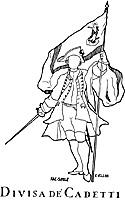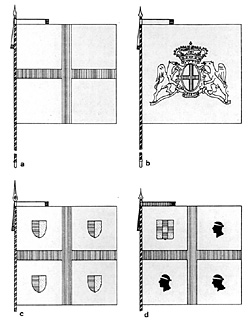 In the period starting from 1700 untill the middle of the century Italy, together with Flanders and the Rhine country, was the theatre of many battles. In the various wars most of the Italian states were involved at different stages, having too small dimentions to be able to oppose the Spanish, French or Imperial armies, even only to maintain the declared neutrality, when it was not their same territory the object of the contending.
In the period starting from 1700 untill the middle of the century Italy, together with Flanders and the Rhine country, was the theatre of many battles. In the various wars most of the Italian states were involved at different stages, having too small dimentions to be able to oppose the Spanish, French or Imperial armies, even only to maintain the declared neutrality, when it was not their same territory the object of the contending.
As it might be known in the 17th and 18th centuries the existance of the Most Serene Republic of Genoa was often shaken with many adversities and its small army did not live in peace, especially in the 17th century (wars against the duke of Savoy, several bombardments by the French navy).
In the Wasaw treaty, that signed the end of hostilities of the Polish succession war (Seven Years War), the territory of Finale (on the Ligurian coast) was given, with the help of the Austrian diplomacy as an old Imperial fief, to the Kingdom of Sardinia, notwithstanding the fact that it had in the past been sold to the Republic. This fact inflamed the Genoans and when in 1745 hostilities broke out once more between the Austrian Empire and the Kingdom of Sardina on one side and France Spain, the duchy of Modena and the Kingdom of the Two Sicilies on the other, the republic sent in Lombardy an army of corps of about 8000 men to fight against Sardina and the Empire.
Collapse of the Bourbonian Armies
After some successes in the early part of the campaign the Ligurian army was involved in the collapse of the Bourbonian armies and the republic, left pratically alone, could not compete with the troops of the enemy led by the Field Marshal Botta Andorno and was compelled to capitulate.
As a consequence the town of Genoa was occupied by Austrian troops, but in December of 1746 the people rose in revolt against the occupants and organizing militia units expelled foreign troops from the town. A land siege ensued carried out by the Austrian and Sardinian troops and a naval blockade by British vessels was also established. Genoa was able to resist, also because of help that the allies succeded to get into the city, until the enemies had to raise the siege in the fear of a new offensive that the French and Spanich armies were about to launch against Piedmont.
In the peace signed in 1748 Genoa obtained all its previous territories (Finale included).
In 1737 by the Magistrate of War of the Republic was initiated the first important reform of the old structures of the Genoan army, which at that time numbered 6,932 officers and men. Following the example of most European countries and especially of the nearby Kingdom of Sardinia, an old time opponent, the organization of the troops shifted from the company basis, as was practised, to battalion formation. (1)
Genoan Army
The Genoan army was thus composed of natioonal batalions, mercenary Italian battalions (with men not originaly of the republic territory), Swiss and Grisons, and Corsicans.
In 1741 the Genoan army underwhent a reorganisation following which new uniform colours were assigned to infantry battalions (see table A). In 1742 in the Corsican and mercenary battalions grenadier companies were established, becoming the fifth companies of each battalion; only in 1744 the other corps received their grenadier companies. In 1745, on the occasion of the war regiments were created from the existing battalions, while new units were also being raised (see table B).
Battalions, according to the custom, were given the name of the commanding officer; national battalions, mercenary and Corsican battalions were composed of five companies and regimental staff. The staff was composed by the colonel, a major, a (staff) adjutant, a quartermaster major and, in war, a chaplain and surgeon were added.
The strength of each company included one captain, a lieutenant, an under-lieutenant or a standard bearer (2), two sergeants, four corporals, two distinguished soldiers, two drummers, a "chief of grenadiers", 12 grenadiers and 79 privates up to a total of 106 men
Army Increase
By a decree of January 16th 1744 it was decided to increase the army up to 8000 men, creating a sixth company in the Italian and Corsican battalions, while increasing the strength of the companies to 120 men, so that each battalion should have 720 men. Swiss battalions were instead formed by four companies to one of which, called the colonel's, the commanding colonel, the chaplain and the surgeon were attached. Each company was composed of one captain, a lieutenant, an under-lieutenant or standard bearer, a first and a second sergeant, two under-sergeants, 8 corporals, one quartermaster, 5 drummers and fifers, 24 grenadiers and 154 privates.
Genoan troops that entered the campaign together with the French, Spaniards and Neapolitans against Austrians and Sardinians were organised into 3 divisions. Francesco Brignole Sale was appointed commander in chief of the operational army.
The General Staff was composed of:
a general commissary (Francesco Brignole Sale himself),
a general inspector De Farrari,
a lieutenant general Count de Cecil (French)
and two field Marshals Villiers (French) and Giacomo Scher.
1st Division
Regiments Geraldini (2 battalions), Giacomone (1), Hambracht (1), Bembo (1)
2nd Division
Varenne (2), Jost (1), Vincenti (1) De Franceschi (1)
3rd Division
d'Arnaud (1), Crettler (1), Grimaldi (1), Jost (1)
Uniforms
The uniform of the soldiers was composed of a cost of wollen cloth with cuffs and lining of the regimental colour. As a general rule Italian battalions had a white coat, Corsican blue, and Swiss red or blew,
The coat was worn unlaced and with turn-backs turned up and had 24 large buttons, tin or brass, horizontal pocket flaps, which in 1744 became instead vertical for some of the units.
The clothing of the Genoan soldier also included a vest and trousers, coloured stockings, a linen neck tie, a shirt, raw linen gaiters that reached above the knee and a pair of black cow hide shoes with an iron buckle.
Men of the ordinary companies wore a black felt tricorne hat, with a white (for the majority of the corps) or yellow lace border. For the officers and NCO's the borders were silver or gold. The cockade was in the Republic's colours, ie. white and red. Grenadiers wore a bearskin with a cap of the regimental colour ending in a tassel of the hat lace (silver or golden for officers and NCO's).
NCO's wore as a rank badge two inches of lace over the cuffs, in whire or yellow wool for corporals and golden or fake silver for sergeants. Sergeants were furthermore armed with an halebard (also called a "sargentina") approximatly 2.2 meters (7 1/4 feet) in length. Officers carried the pike and had a dress of finer quality than the soldiers. The well known military painter Cenni represents officers with a sholder bandolier of the regimental colour with silver or golden borders, we tend to believe instead that they carried a waist belt of the same material, as was the use in the French and Spanish armies. Officers also carried a stick that an order of 1/1/1700 regulated.
Drummers and fifers uniforms had white and red lace on the seems of the coat and a fringe - knot on the right sholder (see Table 4). Drums were painted in white and red triangles bearing in the middle the Republic's Arms ans, at least in some instances, the family's Arms of the commanding officer. Muskets were quite certainly of a French model. (3) NCO's, grenadiers, drummers and fifers carried a sabre. Waist and cross belts were of yellow leather with a black pouch. On campaign soldiers carried their belongings in canvas sacks and were supplied with an iron flask with a matted straw cover.
 Standards
Standards
Each regiment had three standards, a colonel's and two flank company's, that were entrusted respectively to the company of the colonel and to the two most senior captains. The standards were square (about 2.5m x 2.5m or 8' x 8') the pole had red and white painted spiralling. The colonel's standard was white bearing in the centre the Arms of the Republic and, very likely on the back a Madonna; ordinary standards carried St. George's red cross on a white field. (4) Cenni represents some of these standards with the Arms inside the four fields (see Fig. 1). At the Archivio Storico Comunale of Genua there exists a collection of contemporay paintings illustrating the uniforms of many of the militia units raised in 1746 that defended the city during the Austrian siege. A facsimile of the ensign of the Cadetti Volontari company is taken from this collection, notice the image of a Madonna in the first quarter of the standard (fig. 2).
Notes
1. Archivio di Stato Genova (ASG) O. Foglietta, Filza 336.
2. There were only three standard-bearers in each battalion.
3. ASG. Diversorum Collegi, filza 253 and Militaruium filza 13, 2873
4. At the Armeria Reale in Turin there is a Genoan standard (catalogue no A.R. 0.3), very likley a company standard; the Schweizer Fahnenbuch by A. and B. Bruckner carries a standard (no 994) believed milanese, we think insteead a Genoan colonel's standard; these flags could have been captured by the Sardinians in Lombardy.
Back to 18th Century Military Notes & Queries No. 12 Table of Contents
Back to 18th Century Military Notes & Queries List of Issues
Back to Master Magazine List
© Copyright 1996 by Partizan Press
This article appears in MagWeb (Magazine Web) on the Internet World Wide Web.
Other military history articles and gaming articles are available at http://www.magweb.com